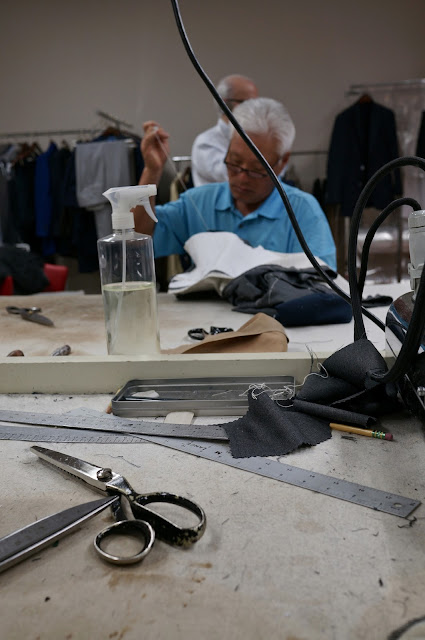When I visited US tailor Chris Despos last month I was slightly surprised to find that his house cut was so Italian in style. I think in London we often forget the influence of the Italians on US clothing – due to immigration, the openness of the market and its sheer size. It seems odd to an Englishman that Belvest or Isaia would be available in New York but not London, given our proximity to Italy, but the wealth and number of US consumers is a far bigger factor.
Chris has two Italian coatmakers in Chicago and recently added an Italian apprentice, from Sartoria Gallo in Rome. There is also a trouser maker in Chicago and two finishers in Dallas – where these pictures were taken. The finishers also prepare all the basted fittings for Dallas, once Chris has cut them, but they’ve never managed to get to the stage where they can do the full make. “It’s the Italian shape in the chest and the shoulders that is hard to replicate,” says Chris.
In fact, the two coatmakers are from different parts of Italy – Rome and Bari, in the south – and as a result make slightly different jackets. As you might expect, the Bari style is softer and more natural, while the Roman maker (who trained at Cifonelli, Italy in the 1950s) puts in more structure.
“The nice thing now is that men understand the difference,” says Chris. “My customers used to be mostly guys who just, for whatever reason, couldn’t get ready-to-wear. Now they are more discerning.” It’s not surprising that the trend of more educated and formal dressing has spread to Chicago and Dallas, but it’s good to hear.
One construction point Chris particularly favours is a forward-sloping, and curving, shoulder seam (below). This is quite unusual. All of the tailors I have tried have either a straight or a backwards-sloping seam (the latter at Anderson & Sheppard and some Italians). Interestingly, Chris thinks he is achieving the same thing with his seam as with a backwards-sloping version: making the shoulder more comfortable and allowing the jacket to move with the customer, rather than fighting against him.
I don’t have any suits from Chris so I can’t make any comment on the effect, but I do know from practical experience that tailors’ much-treasured techniques are sometimes easily replicated in other ways – but if one works, why change it? Chris’s attitude is more open: “In the end, it’s whatever produces a well-fitting, comfortable suit. You have to keep an open mind and never stop learning.”
The pictures here are of a suit being made for Kirby Allison of The Hanger Project. At this first fitting it looked good.




































Fascinating! Not at all to my taste, but Despos is a master. Though the US has the Italian clothes you desire, we are sorely lacking in English style. Most Americans think of Italy as the height of men’s clothing, without knowing a thing about England’s contribution.
Chris’ stuff is so awesome.
I once took a carbon framed race car around the track a few times (Ferrari Scuderia). When the instructor bragged in the intro that the Ferrari was made of carbon fiber, it meant nothing to me, but then I “raced” it and it was like wow, this is how a car should feel.
Wearing Chris’s forward-sloping shoulder for the first time is similar. One may not understand it, but once he puts it on, he’ll get it…..”Oh, this is how bespoke should feel.”
Alex
Interesting report. I’m glad we Americans are more in sync with the Italian cuts (although it is surprising given our frames). At any rate I wish I could see the differences you point out illustrated. It’s so difficult to imagine the two dimensional fabric being manipulated three dimensionally in so many different ways. Almost like origami.
They don’t make them like that anymore!! A quote from a custom tailor in Miami. Mr. Despos has made several garments for me and they are beautiful and will last a life time. Highly recommended.
I find all of this chit chat about Italian/English tailoring amusing more than fifty percent of the tailors in the West End are from Europe wether that be Italy Spain Greece Hungary or further afield like Japan; they have all influenced the final ‘English’ product
Sure Peter, but that doesn’t really affect the style references we’re talking about. The English style is still consistent, wherever the makers are from.